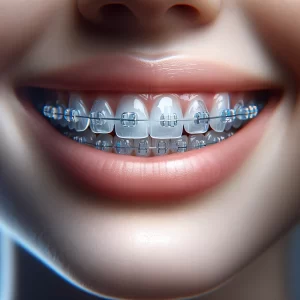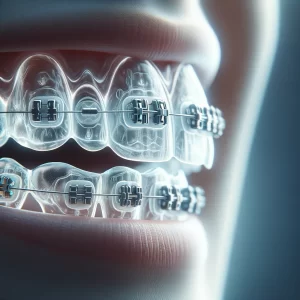Are you curious about clear braces and how they stand apart from the classic metal braces we’re all familiar with? Clear braces are a form of orthodontic device that aim to align and straighten teeth while offering a less noticeable appearance, utilizing materials that blend in with the natural color of your teeth, as opposed to the more conspicuous metal brackets and wires. They provide an alternative for those seeking a subtler orthodontic treatment option, while still addressing similar dental alignment issues.

Definition of Clear Braces
Clear braces are a form of orthodontic treatment that aim to align and straighten teeth while offering a less noticeable alternative to traditional metal braces. Unlike their metal counterparts, clear braces are designed with transparency in mind, utilizing materials that blend in with the natural color of the teeth. This makes them a popular choice for individuals who are conscious about the aesthetics of their smile during orthodontic treatment. For a visual understanding of their discreet appearance, one might wonder, What do clear braces look like when worn on the teeth? The primary difference between clear braces and traditional metal braces lies in their visual impact. While both types serve the same functional purpose—to correct misaligned teeth and improve dental health—clear braces are less visible, which can be an important consideration for adults and teens who are concerned about the prominence of orthodontic devices in social or professional settings. The materials used in clear braces are typically ceramic or a composite that mimics the shade of tooth enamel, thus providing an inconspicuous way to achieve dental alignment goals.

Composition of Clear Braces
Clear braces, often sought after for their less noticeable appearance, are composed of various materials that distinguish them from their traditional metal counterparts. Unlike the conspicuous metal brackets and wires used in conventional braces, clear braces utilize a combination of ceramic or plastic materials that blend more seamlessly with the natural color of teeth. These materials are engineered to provide the strength necessary for effective teeth alignment while offering an aesthetic advantage. The brackets are typically made from a transparent ceramic material, and in some cases, they may be enhanced with a tooth-colored resin to further reduce visibility. The wires that connect the brackets can also be less visible. They are sometimes made of a nickel-titanium alloy with a tooth-colored coating, allowing them to blend in more discreetly with the teeth. This combination of materials is designed to move teeth into the desired position effectively while maintaining a subtler look throughout the treatment process. For those interested in exploring these aesthetically pleasing orthodontic options, Invisible Braces Available in Kennesaw may provide a solution that aligns with both dental goals and personal preferences.
Aesthetics: Clear vs. Metal Braces
When considering orthodontic treatment, aesthetics often play a significant role in the decision-making process. Clear braces present a less noticeable alternative to traditional metal braces, catering to those who prefer a more discreet option. The primary difference lies in the materials used; clear braces are typically made from ceramic or plastic compounds that blend in with the natural color of teeth, whereas metal braces are constructed from stainless steel or metal alloys, making them more visible. This contrast in visibility can influence an individual’s choice based on their personal comfort and aesthetic preferences during orthodontic treatment.
Durability and Maintenance Considerations
When comparing clear braces to traditional metal braces, it’s important to consider the aspects of durability and maintenance. Clear braces are typically made from composite materials that are designed to blend in with the natural color of your teeth, offering a less noticeable orthodontic solution. While they are strong and capable of withstanding the rigors of daily wear, they may require a different approach to care to maintain their discreet appearance. On the other hand, metal braces are known for their robustness and have a long-standing track record of enduring the demands of orthodontic treatment. Maintenance routines for both types of braces are crucial for their effectiveness and longevity, but the specific practices may vary due to the materials used in their construction. For personalized advice on the durability and maintenance of orthodontic options, consulting with an orthodontist is recommended. If you’re in the area and considering your options, an Orthodontist Kennesaw can provide professional guidance.
Treatment Process Comparison
When considering orthodontic options, it’s important to understand the differences in the treatment processes between clear braces and traditional metal braces. Both methods involve regular adjustments to gradually align teeth over time. Traditional metal braces are often more visible, consisting of brackets attached to the front of the teeth and connected by wires, which are periodically tightened by an orthodontist to shift teeth into the desired position. Clear braces, on the other hand, are less noticeable as they are made of transparent or tooth-colored materials. The adjustment process for clear braces is similar to that of metal braces, but they may require more meticulous maintenance to avoid staining. Each type of braces has its own protocol for application, maintenance, and removal, which should be discussed with an orthodontic professional.
Conclusion
For further inquiries on orthodontic options, feel free to read our reviews on Google Maps or call us at 678-275-2066.

